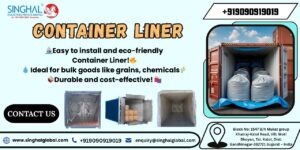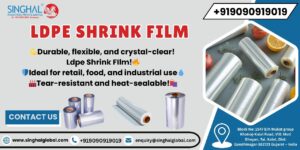Thermal Plastic Urethane was invented in 1937 and has been utilized for years to produce a distinct category of films. TPU films are chosen over conventional films such as PVC, PP, and PE, due to several features. They develop and produce a wide range of biocompatible thermoplastic polyurethane tpu films that are both elastic and flexible, with exceptional mechanical and physical qualities. TPU films are used in biomedical items, safety gear, and medical equipment for commercial and public healthcare industries. These substances elevated risk in making plastic laminate films, translucent layers, textile barrier coverings, barrier films, surface available treatments, sealed translucent bags, inflated sacs, and various other things.
Singhal Industries Pvt. Ltd. TPU film manufacturer offer diverse films that rely on either polyester or polyether reactive PU polymer techniques. Versatility is paired with great friction wear, rip toughness, and puncture resistance, even at low pressures, as well as excellent rigidity to vapours, air, water, fuel, and solvents. As a result, they are great, strong, thin-film material choices for items that must be comfortable and strong.
Premium quality grades have been produced for medical devices and healthcare products that combine therapeutic efficacy with excellent protection for fungal and bacteria development. TPU film manufacturers implement additive services to create films that can withstand microbial development, such as E Coli and MRSA. To maximize efficiency and eliminate scrap, tpu films are mixed, and blown film extruded in-house, sliced to diameter, and looped to order in roll sections. Medical bedding, blood pressure monitors, infusion bags, and operating robes are just a few of the applications for these films. Good moisture resistance is one of the advantages of Polyether tpu films. Resistance to fungi, microbes, and body oils is exceptional.
Inserts for Mattresses, Duvets, and Pillows
Prominent makers of wipe-clean bedsheets, linens, and pillows employed in the healthcare business profit from the production and operational advantages of TPU films. Versatile specialty fabrics are often heat-fused or adhesively attached to underlying polymers and textiles; TPU films can be manufactured using either procedure. TPU film manufacturers are offering healthcare duvet and bed linen item producers a variety of non-allergenic film level choices, developed with effectiveness and higher levels of positive as required, such as combustibility resistance, steam flowability, and pollutant safety, including MRSA resistance.
Welded Bladders, Gel Pads, and Pressure Pads
TPU films are robust and waterproof while maintaining flexibility and gentle to the feel. As a result, they are an excellent film substance for therapeutic gel pads and pressure-relieving pads used on beds and wheelchairs. Relaxation is paired with excellent shred and penetration resistance and natural two-phase flow protection, and anti-fungal characteristics. TPU films are also utilized to make water or gas-filled sealed air sacs, which may be made cheaply using traditional HF and acoustic welding procedures.
Mattresses that distribute pressure
Major OEMs of pressure reduction and redistribution mattresses used in hospitals and the healthcare sector demand tpu films. The unique bedding structure helps stop and controls pressure ulcers. TPU films have proven to be an excellent choice as an easy-to-manufacture, long-lasting protective film in fabric systems used in the design of air, gel, and water-filled pressure relief mattresses. The intended low firmness grade blends suppleness with excellent mobility to deliver the desired degree of comfort. The film’s absorption to air and water, good endurance, rupture resistance, resistance to degradation and microbiological growth are all important qualities for this advanced use.
Hollow-Fiber Devices with Liquid Polyurethanes
Selecting Fabric Hollow-fiber membranes transformed the design of blood-processing barrier devices such as hemodialyzers, oxygenators, and hemoconcentration. Before the introduction of hollow-fibre membranes, the majority of these gadgets utilized flat-sheet polymers. The flat-sheet membrane gadgets were hard to construct and had high permeability. TPU films manufacturers had to figure out how to hold the threads, dividing the interior of the inner wall externally. To increase the blood flow solely on a single intermembrane space and a medicinal solution to flow on another, the two parts of the membrane must be divided. The barrier portions were sealed with a two-part liquid polyurethane as a mixture. The transplanting material serves as a structural element that divides the membrane’s two sides.
Dip Molding Polyurethanes
Polyurethanes are also suitable for producing dip-moulded products such as airbags, probe wraps & mittens. Even though natural fibre (NRL) is substantially less costly, the benefits of employing polyurethanes are enormous. The absence of extractable compounds in polyurethanes is the most serious issue. Polyurethanes, whereas NRL, are perfect polymers, which means that all of the constituents are organically bonded to one another. NRL is abundant in natural products such as tree proteins and curing compounds. These chemicals can produce rashes, allergy symptoms, and, under the worst scenario, anaphylactic shock, which can be disastrous. Healthcare practitioners are especially vulnerable to these illnesses since they undertake several duties while wearing rubber gloves.
Polyurethane Coatings
High-strength polymers with medical device features are not always the best material options for inserting into the body. Heparin coatings, for example, are put to a range of devices made of PVC, polyamide, and polyurethane to improve their thromboresistance. Similarly, their adaptability makes them ideal for a variety of applications. Polyurethane coatings can be hydrophilic or hydrophobic, antibacterial, non-thrombogenic, narcotic, or determinant. The coatings are suitable solvent and transferred to the surface by dropping or sprinkling. A polyurethane coating has the same chemistry as pure polyurethane. The good mechanical qualities of the material result in coverings that are strong, durable, and scratch-resistant.
Polyurethanes with Biostability
Polyurethanes used in long-term implantation offer unique problems to product manufacturers. Pacemaker connections were among the early applications of polyurethane for prostheses. The polyurethane utilized was polyether-based and functioned admirably. After several years in the system, the typical polyether-based polyurethane started showing signs of deterioration. Some elements, such as cobalt, promote such degradation. This is especially the case in pacemaker connections, where the wire’s ionic cobalt catalyzes oxidizing. The physical attributes of polyurethane deteriorate as it reacts with oxygen.









